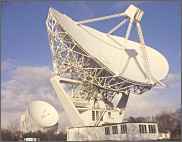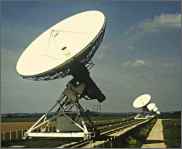
|
|||
|
The Quest for High Resolution |
|
Arrays The technique can be extended to link together a number of telescopes to form an array. At a given instant of time each pair of telescopes in the array gathers some information about the structure of the observed radio source. As the Earth rotates, the orientation and effective baselines of the telescope pairs change allowing them to gather further information. After 12 or more hours of observation, sufficient data are acquired to enable a radio image of the source to be made. The technique is called Earth Rotation Aperture Synthesis. Linking the telescopes The
signals from the telescopes can be brought together in several
different ways. Where the telescopes are on one site, cables
or waveguides are used. Where greater distances separate the
telescopes, as in MERLIN, microwave radio links are used at
present, but these may be replaced by fibre-optic links for
greater bandwidths and sensitivity. When the telescopes in the
array are spaced across a continent, it is not currently feasible
to combine their signals as they are received. Instead, the
data are stored on large reels of 1" wide magnetic tape
with each block of data precisely "time stamped" to
better than a microsecond. The tapes from each observatory are
then brought to a processing site where they are played back
in precise synchronisation before being combined together in
a computer to form radio images. The largest array located on one site is the Very Large Array (VLA) in New Mexico, USA where the telescopes can be up to 36 kilometres apart. This provides a typical resolution of 1/3 of a second of arc, similar to that of optical telescopes operating on the Earth's surface. The 217 km MERLIN array, shown on the inside cover, can typically provide a resolution of 1/20 of a second of arc, comparable to images produced by the Hubble Space telescope, whilst the European VLBI Network (EVN) gives a further factor of ten improvement. The 5 km Ryle Telescope operated by Cambridge University where Martin Ryle and colleagues developed the technique of Earth Rotation Aperture Synthesis.
|

